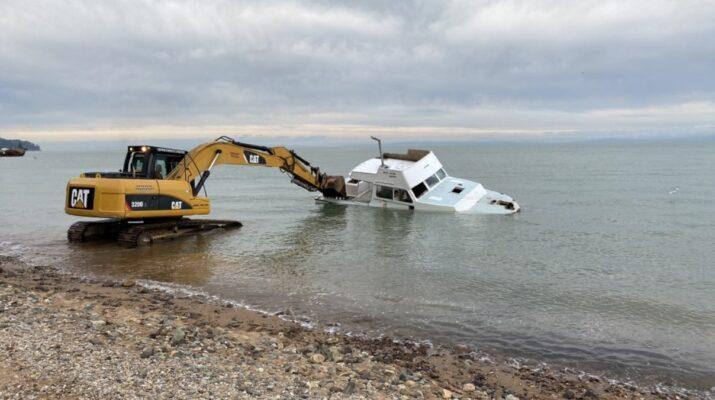Harbourmaster news
The Waikato Regional Harbourmaster has a simple message for owners of old, derelict vessels moored in the region: Please manage your boat properly to avoid it turning into a crisis and a costly burden on ratepayers. The photo shows Council contractors pulling a 36-foot boat ashore at Waiomu for demolition and disposal after it was holed by rocks in February 2024. The vessel was in very poor condition and unable to be repaired. The council ensured there was no oil spilt and then managed the salvage situation.
On average, Waikato Regional Council’s Maritime Services team has to recover four vessels each year which have either sunk on their mooring, or their mooring has failed or broken and the vessel has grounded or sunk.
The cost to ratepayers of dealing with each of these vessels can vary from $5000 to as much as $50,000.
“This is a big problem for us in the Waikato just as it is for regional councils across Aotearoa,” says Chris Bredenbeck, the regional harbourmaster.
“It’s unwanted work for the council due to the owners of the vessels not having the funds or capacity to manage their own vessels.
“There are unfortunately dozens of very old vessels across our harbours which are not being maintained and reaching a point where they are irreparable.”
The boating bylaws require that vessels be seaworthy at all times when on the water and it is the owner who is responsible.
Most problem vessels are among the approximately 850 ‘zoned moorings’ in the Waikato region.
Maritime Services staff do regular patrols, looking for vulnerabilities in the mooring lines.
“When we spot an issue with a vessel, we try to locate the owner and highlight the risk to them with the aim of getting the owner themself to remedy the situation,” says Bredenbeck.
Weather can be a hugely problematic factor and may result in a vessel breaking vulnerable moorings. During Cyclone Gabrielle, for example, six vessels in the Waikato came away from their moorings and were either grounded or sank.
“We may find ourselves having to pump the fuel tanks to remove contaminants from the vessels and stop them entering the water. Once that is managed, we move on to considering the navigation safety issues. Is the vessel going to be a hazard for other vessels?
“We do try to recover the costs from the owner for the work where we can.”
Bredenbeck says warrant of fitness or safety inspection would be a useful tool in helping to manage vessels, although a bigger priority is the licensing of skippers.
“We advocate strongly for skipper licensing, which would ensure that vessel owners would be aware of the rules and their obligations around boating safety – but this would require change at central government level.
“The simple fact is that people need to maintain their boats. This includes having the proper equipment, such as an automatic bilge pump, checking their vessels regularly and paying close attention to how their vessel is connected to its mooring.
“After a heavy weather event, go check on your boat and make sure everything is in order.”
For people with old boats on moorings, it’s important for owners to make an honest assessment of their situation.
“If your boat has had its day, consider getting rid of the vessel and selling the mooring. It will save you a lot of potential trouble and cost, and free up the mooring for someone else.”
Maritime Services are available to give advice and put owners in touch with professionals who can help.

